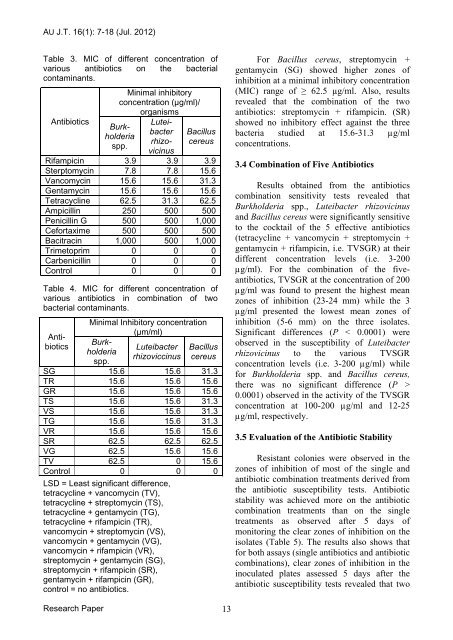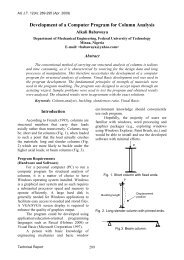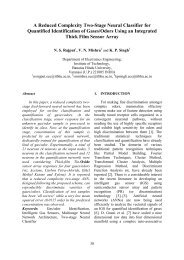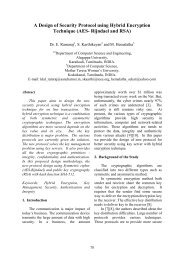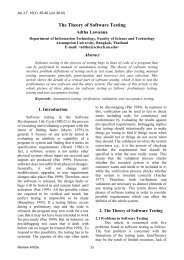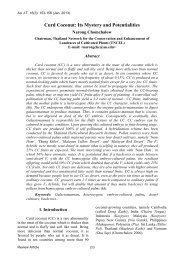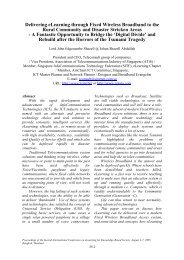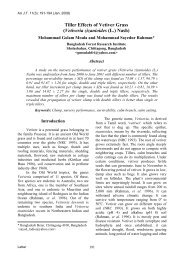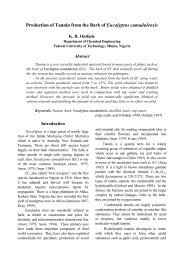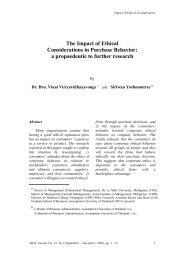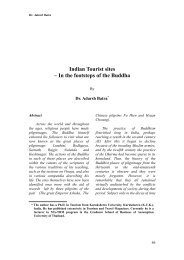Screening Antibiotics for the Elimination of Bacteria ... - AU Journal
Screening Antibiotics for the Elimination of Bacteria ... - AU Journal
Screening Antibiotics for the Elimination of Bacteria ... - AU Journal
You also want an ePaper? Increase the reach of your titles
YUMPU automatically turns print PDFs into web optimized ePapers that Google loves.
<strong>AU</strong> J.T. 16(1): 7-18 (Jul. 2012)<br />
Table 3. MIC <strong>of</strong> different concentration <strong>of</strong><br />
various antibiotics on <strong>the</strong> bacterial<br />
contaminants.<br />
<strong>Antibiotics</strong><br />
Minimal inhibitory<br />
concentration (µg/ml)/<br />
organisms<br />
Burkholderia<br />
spp.<br />
Bacillus<br />
cereus<br />
Rifampicin 3.9 3.9 3.9<br />
Sterptomycin 7.8 7.8 15.6<br />
Vancomycin 15.6 15.6 31.3<br />
Gentamycin 15.6 15.6 15.6<br />
Tetracycline 62.5 31.3 62.5<br />
Ampicillin 250 500 500<br />
Penicillin G 500 500 1,000<br />
Ce<strong>for</strong>taxime 500 500 500<br />
Bacitracin 1,000 500 1,000<br />
Trimetoprim 0 0 0<br />
Carbenicillin 0 0 0<br />
Control 0 0 0<br />
Table 4. MIC <strong>for</strong> different concentration <strong>of</strong><br />
various antibiotics in combination <strong>of</strong> two<br />
bacterial contaminants.<br />
Minimal Inhibitory concentration<br />
(µm/ml)<br />
Luteibacter<br />
rhizovicinus<br />
<strong>Antibiotics</strong><br />
Burkholderia<br />
spp.<br />
Luteibacter<br />
rhizoviccinus<br />
Bacillus<br />
cereus<br />
SG 15.6 15.6 31.3<br />
TR 15.6 15.6 15.6<br />
GR 15.6 15.6 15.6<br />
TS 15.6 15.6 31.3<br />
VS 15.6 15.6 31.3<br />
TG 15.6 15.6 31.3<br />
VR 15.6 15.6 15.6<br />
SR 62.5 62.5 62.5<br />
VG 62.5 15.6 15.6<br />
TV 62.5 0 15.6<br />
Control 0 0 0<br />
LSD = Least significant difference,<br />
tetracycline + vancomycin (TV),<br />
tetracycline + streptomycin (TS),<br />
tetracycline + gentamycin (TG),<br />
tetracycline + rifampicin (TR),<br />
vancomycin + streptomycin (VS),<br />
vancomycin + gentamycin (VG),<br />
vancomycin + rifampicin (VR),<br />
streptomycin + gentamycin (SG),<br />
streptomycin + rifampicin (SR),<br />
gentamycin + rifampicin (GR),<br />
control = no antibiotics.<br />
For Bacillus cereus, streptomycin +<br />
gentamycin (SG) showed higher zones <strong>of</strong><br />
inhibition at a minimal inhibitory concentration<br />
(MIC) range <strong>of</strong> ≥ 62.5 µg/ml. Also, results<br />
revealed that <strong>the</strong> combination <strong>of</strong> <strong>the</strong> two<br />
antibiotics: streptomycin + rifampicin. (SR)<br />
showed no inhibitory effect against <strong>the</strong> three<br />
bacteria studied at 15.6-31.3 µg/ml<br />
concentrations.<br />
3.4 Combination <strong>of</strong> Five <strong>Antibiotics</strong><br />
Results obtained from <strong>the</strong> antibiotics<br />
combination sensitivity tests revealed that<br />
Burkholderia spp., Luteibacter rhizovicinus<br />
and Bacillus cereus were significantly sensitive<br />
to <strong>the</strong> cocktail <strong>of</strong> <strong>the</strong> 5 effective antibiotics<br />
(tetracycline + vancomycin + streptomycin +<br />
gentamycin + rifampicin, i.e. TVSGR) at <strong>the</strong>ir<br />
different concentration levels (i.e. 3-200<br />
µg/ml). For <strong>the</strong> combination <strong>of</strong> <strong>the</strong> fiveantibiotics,<br />
TVSGR at <strong>the</strong> concentration <strong>of</strong> 200<br />
µg/ml was found to present <strong>the</strong> highest mean<br />
zones <strong>of</strong> inhibition (23-24 mm) while <strong>the</strong> 3<br />
µg/ml presented <strong>the</strong> lowest mean zones <strong>of</strong><br />
inhibition (5-6 mm) on <strong>the</strong> three isolates.<br />
Significant differences (P < 0.0001) were<br />
observed in <strong>the</strong> susceptibility <strong>of</strong> Luteibacter<br />
rhizovicinus to <strong>the</strong> various TVSGR<br />
concentration levels (i.e. 3-200 µg/ml) while<br />
<strong>for</strong> Burkholderia spp. and Bacillus cereus,<br />
<strong>the</strong>re was no significant difference (P ><br />
0.0001) observed in <strong>the</strong> activity <strong>of</strong> <strong>the</strong> TVSGR<br />
concentration at 100-200 µg/ml and 12-25<br />
µg/ml, respectively.<br />
3.5 Evaluation <strong>of</strong> <strong>the</strong> Antibiotic Stability<br />
Resistant colonies were observed in <strong>the</strong><br />
zones <strong>of</strong> inhibition <strong>of</strong> most <strong>of</strong> <strong>the</strong> single and<br />
antibiotic combination treatments derived from<br />
<strong>the</strong> antibiotic susceptibility tests. Antibiotic<br />
stability was achieved more on <strong>the</strong> antibiotic<br />
combination treatments than on <strong>the</strong> single<br />
treatments as observed after 5 days <strong>of</strong><br />
monitoring <strong>the</strong> clear zones <strong>of</strong> inhibition on <strong>the</strong><br />
isolates (Table 5). The results also shows that<br />
<strong>for</strong> both assays (single antibiotics and antibiotic<br />
combinations), clear zones <strong>of</strong> inhibition in <strong>the</strong><br />
inoculated plates assessed 5 days after <strong>the</strong><br />
antibiotic susceptibility tests revealed that two<br />
Research Paper 13


